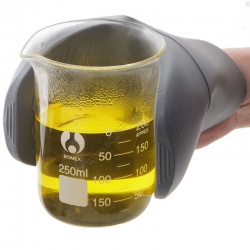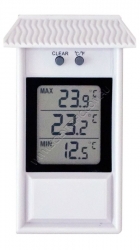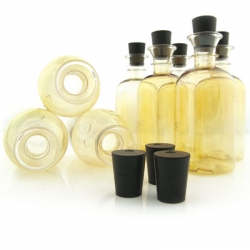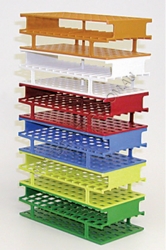81 low relevance results shown for 'Temperature'. Prev |1|2|3|4 | Next | View 100 per page
Showing low relevance matches only. Return to normal search results
Describing biodiversity - Ecosystems are diverse, composed of varied habitats and can be described in terms of their component species, species interactions and the abiotic factors that make up the environment ACSBL021 Year 11 Biodiversity and the interconnectedness of life
Describing biodiversity - In addition to biotic factors, abiotic factors including climate and substrate can be used to and classify environments ACSBL029 Year 11 Biodiversity and the interconnectedness of life
Ecosystem dynamics - Models of ecosystem interactions (for example, food webs, successional models) can be used to predict the impact of change and are based on interpretation of and extrapolation from sample data (for example, data derived from ecosystem surveying techniques ACSBL110 Year 12 Maintaining the internal environment
Homeostasis - Homeostasis involves a stimulus response model in which change in external or internal environmental conditions is detected and appropriate responses occur via negative feedback; in vertebrates, receptors and effectors are linked via a control centre by n ACSCH036 Year 11 Chemical fundamentals
Chemical reactions - All chemical reactions involve the creation of new substances and associated energy transformations, commonly observable as changes in the temperature of the surroundings and/or the emission of light ACSCH060 Year 11 Molecular interactions and reactions
Intermolecular forces and gases - The behaviour of gases, including the qualitative relationships between pressure, temperature and volume, can be explained using kinetic theory ACSCH061 Year 11 Molecular interactions and reactions
Aqueous solutions and acidity - Water is a key substance in a range of chemical systems because of its unique properties, including its boiling point, density in solid and liquid phases, surface tension, and ability to act as a solvent ACSCH063 Year 11 Molecular interactions and reactions
Aqueous solutions and acidity - The concentration of a solution is defined as the amount of solute divided by the amount of solution; this can be represented in a variety of ways including by the number of moles of the solute per litre of solution (mol L1) and the mass of the solute pe ACSCH064 Year 11 Molecular interactions and reactions
Aqueous solutions and acidity - The presence of specific ions in solutions can be identified using analytical techniques based on chemical reactions, including precipitation and acidbase reactions ACSCH065 Year 11 Molecular interactions and reactions
Aqueous solutions and acidity - The solubility of substances in water, including ionic and molecular substances, can be explained by the intermolecular forces between species in the substances and water molecules, and is affected by changes in temperature ACSPH020 Year 11 Thermal nuclear and electrical physics
Heating processes - Provided a substance does not change state, its temperature change is proportional to the amount of energy added to or removed from the substance; the constant of proportionality describes the heat capacity of the substance ACSPH022 Year 11 Thermal nuclear and electrical physics
Heating processes - Two systems in contact transfer energy between particles so that eventually the systems reach the same temperature; that is, they are in thermal equilibrium ACSPH021 Year 11 Thermal nuclear and electrical physics
Heating processes - Change of state involves internal energy changes to form or break bonds between atoms or molecules; latent heat is the energy required to be added to or removed from a system to change the state of the system






81 low relevance results shown for 'Temperature'. Prev |1|2|3|4 | Next | View 100 per page
Showing low relevance matches only. Return to normal search results
Curriculum resources related to 'Temperature'
ACSBL019 Year 11 Biodiversity and the interconnectedness of lifeDescribing biodiversity - Ecosystems are diverse, composed of varied habitats and can be described in terms of their component species, species interactions and the abiotic factors that make up the environment ACSBL021 Year 11 Biodiversity and the interconnectedness of life
Describing biodiversity - In addition to biotic factors, abiotic factors including climate and substrate can be used to and classify environments ACSBL029 Year 11 Biodiversity and the interconnectedness of life
Ecosystem dynamics - Models of ecosystem interactions (for example, food webs, successional models) can be used to predict the impact of change and are based on interpretation of and extrapolation from sample data (for example, data derived from ecosystem surveying techniques ACSBL110 Year 12 Maintaining the internal environment
Homeostasis - Homeostasis involves a stimulus response model in which change in external or internal environmental conditions is detected and appropriate responses occur via negative feedback; in vertebrates, receptors and effectors are linked via a control centre by n ACSCH036 Year 11 Chemical fundamentals
Chemical reactions - All chemical reactions involve the creation of new substances and associated energy transformations, commonly observable as changes in the temperature of the surroundings and/or the emission of light ACSCH060 Year 11 Molecular interactions and reactions
Intermolecular forces and gases - The behaviour of gases, including the qualitative relationships between pressure, temperature and volume, can be explained using kinetic theory ACSCH061 Year 11 Molecular interactions and reactions
Aqueous solutions and acidity - Water is a key substance in a range of chemical systems because of its unique properties, including its boiling point, density in solid and liquid phases, surface tension, and ability to act as a solvent ACSCH063 Year 11 Molecular interactions and reactions
Aqueous solutions and acidity - The concentration of a solution is defined as the amount of solute divided by the amount of solution; this can be represented in a variety of ways including by the number of moles of the solute per litre of solution (mol L1) and the mass of the solute pe ACSCH064 Year 11 Molecular interactions and reactions
Aqueous solutions and acidity - The presence of specific ions in solutions can be identified using analytical techniques based on chemical reactions, including precipitation and acidbase reactions ACSCH065 Year 11 Molecular interactions and reactions
Aqueous solutions and acidity - The solubility of substances in water, including ionic and molecular substances, can be explained by the intermolecular forces between species in the substances and water molecules, and is affected by changes in temperature ACSPH020 Year 11 Thermal nuclear and electrical physics
Heating processes - Provided a substance does not change state, its temperature change is proportional to the amount of energy added to or removed from the substance; the constant of proportionality describes the heat capacity of the substance ACSPH022 Year 11 Thermal nuclear and electrical physics
Heating processes - Two systems in contact transfer energy between particles so that eventually the systems reach the same temperature; that is, they are in thermal equilibrium ACSPH021 Year 11 Thermal nuclear and electrical physics
Heating processes - Change of state involves internal energy changes to form or break bonds between atoms or molecules; latent heat is the energy required to be added to or removed from a system to change the state of the system
Products related to 'Temperature'

Silicon Hot Hand Safety Grip - Glove
SILICON GLOVE
This Glove is made from silicon rubber so it is heat resistant, has good chemical resistance and it more durable than traditional mitts. This heat resistant 'glove' or 'mitt' is essential for the safe handling of hot beakers and pots.
The silicon can with...
Order code: SC7608

Thermometer - Digital Min-Max
DIGITAL MAXIMUM-MINIMUM THERMOMETER.
Large easy to read LCD with 10mm and 12.5mm numbers. Displays current temperature, maximum and minimum temperatures. Wall mountable.
Easy to use front panel controls include:
• Set degrees in Celsius or Fahrenheit
• Clear button to rese...
Order code: SC7611

Mains Power Cable - 240V 3 Pin Plug to IEC C13 Female Plug
A 1.8 metre long, PVC insulated cable fitted with a 240 volt 3 pin wall plug and IEC C13 female plug.
A suitable replacement for many power cables including those supplied with many IEC products including power supplies, magnetic stirrers etc.
For hotplates and similar prod...
Order code: SC9210

Hydro-Electric Generator or Dynamo
This versatile and well made Hydro-Electric Generator (Dynamo) brings hydropower right into your classroom.
Operation:
The Hydro-Electric connects to the tap and the local water supply so that students can directly witness the conversion of water into electricity.
Pro...
Order code: SCHEG

Vernier Water Quality Bottles with Stopper (Box of 8)
VERNIER WATER QUALITY BOTTLES
A box of 8 lightweight, unbreakable PET 300ml bottles with stoppers for general water quality use. The bottle inside is coated with a yellow amorphous carbon layer that provides a barrier to prevent oxygen from entering or leaving the stopper...
Order code: WQ-BOT

Nalgene Test Tube Rack 13mm Blue
This Nalgene branded full-size Unwire™ test tube rack securely holds a full load of 13mm test tubes or centrifuge tubes.
Size: 200 x 102 x 57 mm (LxWxH).
Colour: Blue
Features:
6 x 12 array of 13mm holes.
The ResMer™ manufacturing technology allows this rack t...
Order code: 5970-0313
81 low relevance results shown for 'Temperature'. Prev |1|2|3|4 | Next | View 100 per page



 ,
,